
The yellowtail snapper is an abundant species of snapper native to the western Atlantic Ocean including the Gulf of Mexico and the Caribbean Sea. Although they have been found as far north as Massachusetts, their normal range is along Florida south to the West Indies and Brazil. This species is mostly found around coral reefs, but may be found in other habitats. They occur at depths of from near the surface to 180 meters (590 ft), though mostly between 10 and 70 m. This species can reach a length of 86.3 cm (34.0 in), though most do not exceed 40 cm (16 in). The greatest weight recorded for this species is 4.98 kg (11.0 lb). Yellowtail snapper is a commercially important species and has been farmed. It is sought as a game fish by recreational anglers and is a popular species for display in public aquaria. This species is the only known member of its genus.

The Atlantic bumper is a game fish in the family, Carangidae. It was first described by the "father of modern taxonomy", Carl Linnaeus in the book, Systema Naturae. Atlantic bumper are known to eat smaller fish, cephalopods, and zooplankton.

The yellowtail damselfish is a species of damselfish native to tropical areas such as the Caribbean coast of Panama. Damselfish are abundant in coral reef environments. The International Union for Conservation of Nature lists this fish as being of “least concern”. The species is exploited on a minor scale, for fisheries and the aquarium trade. It may be threatened by the invasive lionfish.

Chloroscombrus is a genus containing two species of tropical to temperate water marine fish in the jack and horse mackerel family Carangidae. Both members are commonly known as bumpers or bumperfish, with one species endemic to the Atlantic and the other to the eastern Pacific. They have a convex ventral profile compared to most other carangids, with small oblique mouths and low dorsal and anal fins. Phylogenetic studies have found they are most closely related to the jacks of the genus Hemicaranx, with these genera plus Selar, Selaroides and possibly Alepes, making up a clade within the Caranginae subfamily. They are predatory fish which live in both inshore and offshore environments ranging from estuaries to the edge of the continental shelf, and are of moderate importance to fisheries.

Megachilinae is the largest subfamily of bees in the family Megachilidae. It includes mason bees, leafcutter bees, and carder bees.
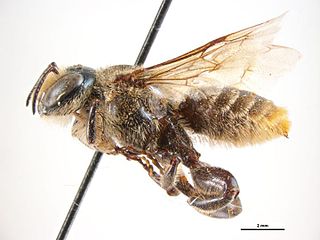
Lithurgus atratus is a species of bee in the family Megachilidae, the mason bees. It is a pollinator of okra in Sri Lanka. It is a host of Chaetodactylus ludwigi, a bee mite.
Megandrena enceliae, the encelia megandrena, is a species of mining bee in the family Andrenidae. It is found in North America.
Megandrena is a genus of mining bees in the family Andrenidae. There are at least two described species in Megandrena.
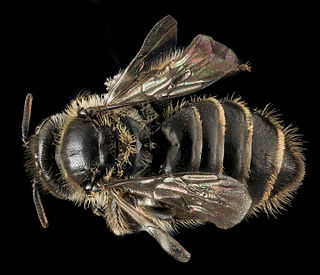
The eastern miner bee is a species of miner bee in the family Andrenidae. It is found in North America. It is a specialist in pollinating Fabaceae plants.

Lithurgus is a genus of bees in the family Megachilidae.
Rhopalolemma rotundiceps is a species of cuckoo bee in the family Apidae. It is found in North America.
Rhopalolemma is a genus of cuckoo bees in the family Apidae. There are at least two described species in Rhopalolemma.
Pseudopanurgus compositarum is a species of bee in the family Andrenidae. It is found in North America.

Triepeolus kathrynae is a species of cuckoo bee in the family Apidae. It is found in the United States and Mexico.
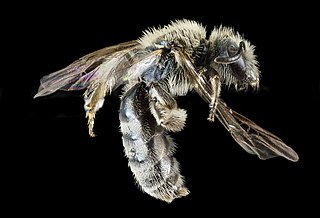
Lasioglossum pavonotum is a species of sweat bee in the family Halictidae.
Ashmeadiella bigeloviae is a species of bee in the family Megachilidae. It is found in Central America and North America.
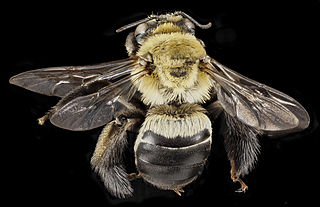
Svastra atripes is a species of long-horned bee in the family Apidae. It is found in North America.

Ceratina cobaltina is a species of small carpenter bee in the family Apidae. It is found in Central America.
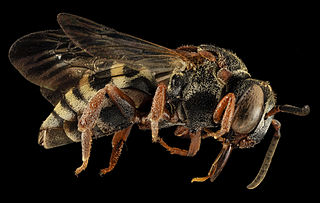
Epeolus scutellaris is a species of cuckoo bee in the family Apidae. It is found in the United States and Mexico.

Hoplitis is a genus of bees in the family Megachilidae. There are more than 380 described species in Hoplitis.













